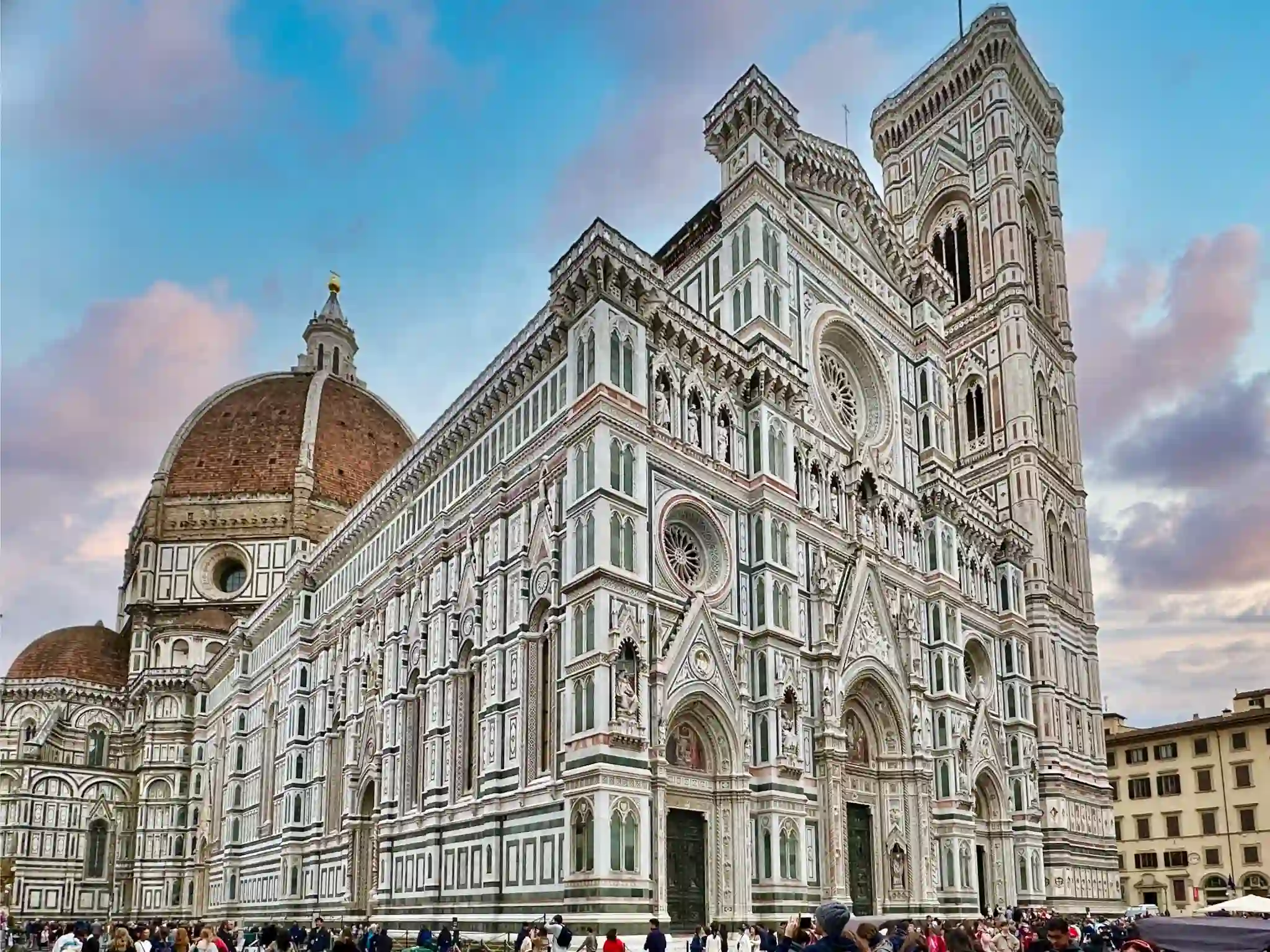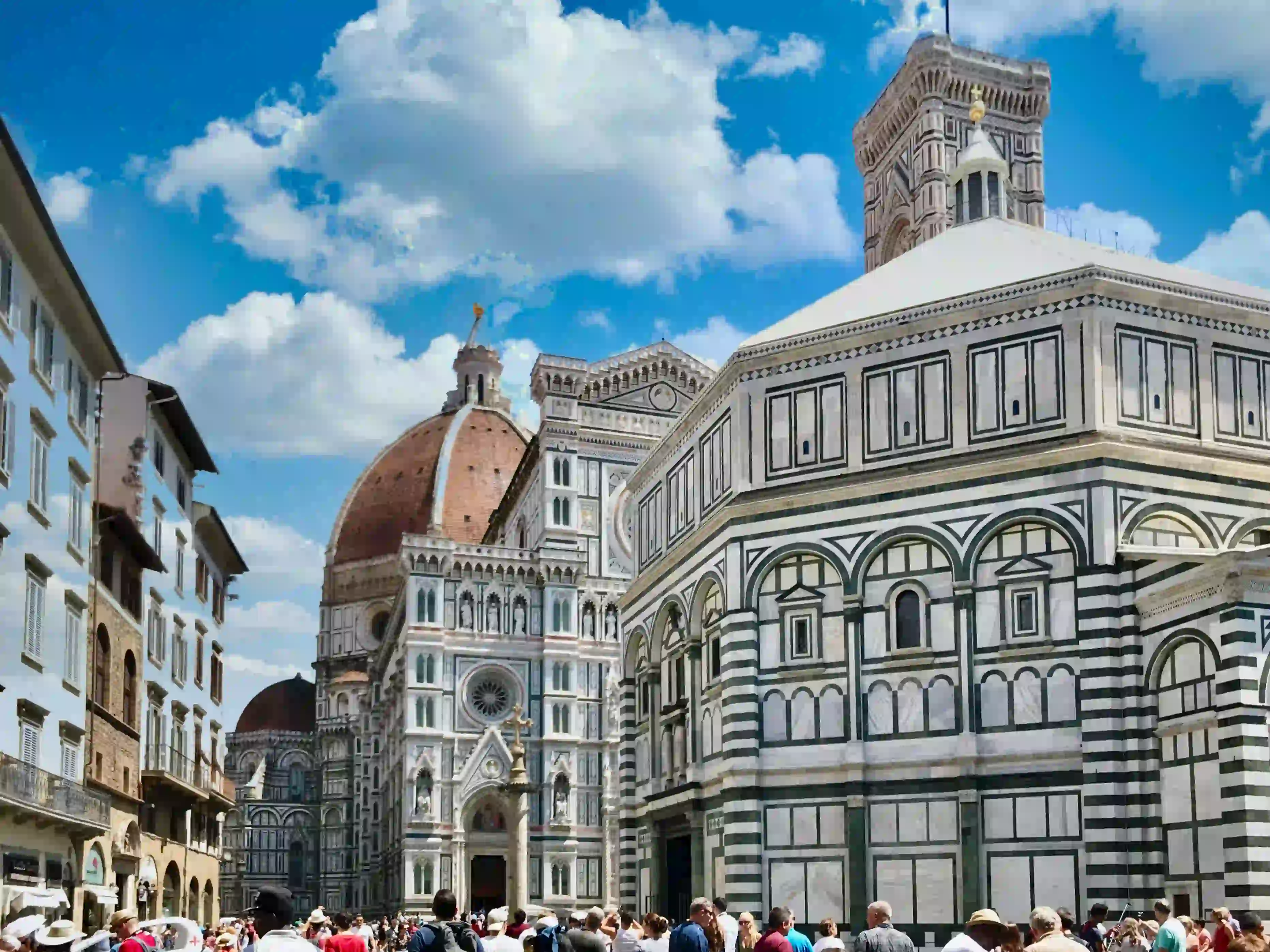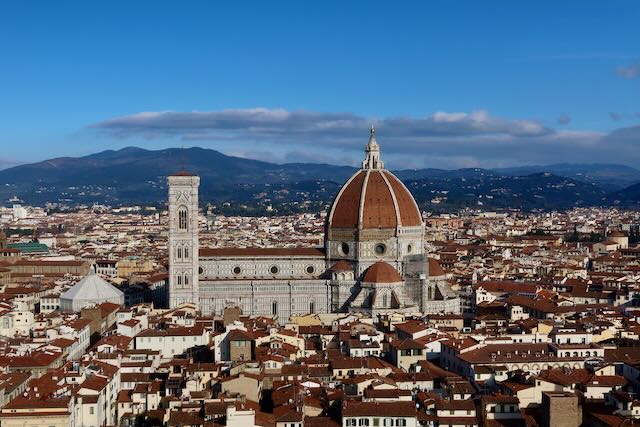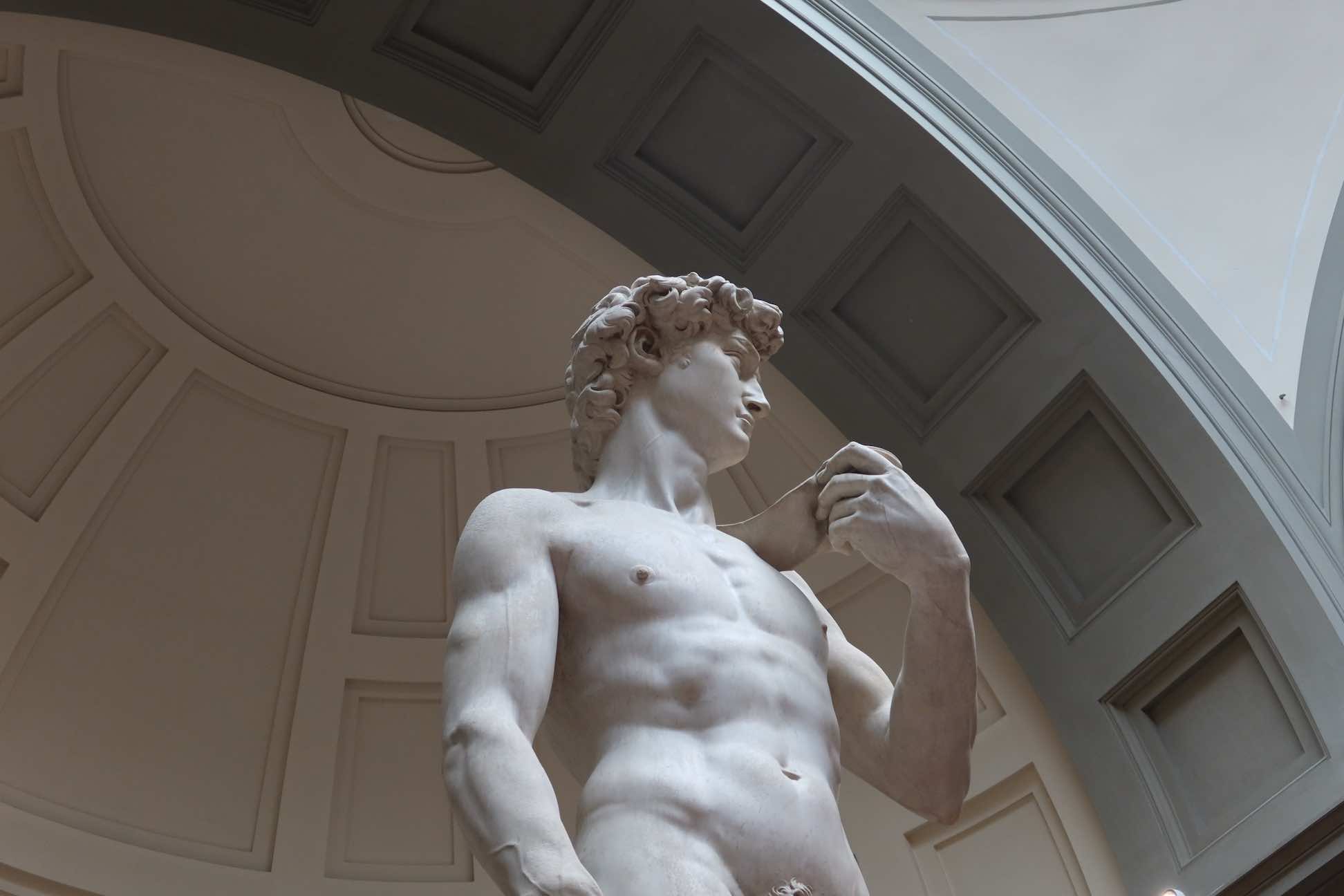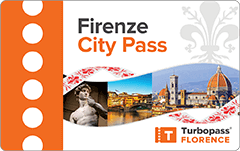- Sign up & get a FREE ebook Subscribe Today!
- Florencewise Home Page
- What to do in florence
- Florence Duomo
Florence Duomo - How To Visit The Cathedral Of Florence
The Florence Duomo complex is one of the most visited places anywhere in Italy, made up of the Santa Maria del Fiore cathedral, Giotto's bell tower, the Baptistery of San Giovanni and the Opera del Duomo museum.
While the word 'Duomo' refers to the whole complex in the Piazza del Duomo, people generally use the word to refer to the Florence cathedral, so let's dive in to discover more!
Visiting the Florence Duomo - Everything you need to know
Florence is like a book that talks about beauty.
The book has been given to us and it is up to us to share it with those visiting this incredibly beautiful city.
And the opening chapter of the book cannot fail to be the Duomo di Firenze.
The cathedral of Florence is one of the focal points of the city, attracting millions of visitors each year as well as being an active place of worship.
While you can, and should, combine your visit to the Florence cathedral with the other sites in the Duomo complex like the Museum Opera del Duomo and Giotto's Campanile, on this page we'll be focusing specifically on the cathedral, including:
- A brief history of the Florence cathedral
- The architecture of the cathedral of Florence
- Special things to see inside the Florence Duomo
- How to see Brunelleschi's dome up close
- Opening hours and mass times
- Where the cathedral of Florence is located and ticket information
A brief history of the Florence Duomo
The original church in Piazza Duomo
The location of the magnificent cathedral has been important to Florence for centuries.
In the early 5th century a church was built in this spot and was dedicated to Santa Reparata, who is a co-patron saint of Florence.
As one of the earliest Christian churches in Tuscany, the Basilica di Santa Reparata became the central place of worship in the area, especially with the Baptistery being right next door.
 You can visit the ancient basilica of Santa Reparata underneath the Duomo by going inside the duomo and heading down the stairs. It's a large space and not claustrophobic. There is a small fee.
You can visit the ancient basilica of Santa Reparata underneath the Duomo by going inside the duomo and heading down the stairs. It's a large space and not claustrophobic. There is a small fee.The original church was relatively small, and despite being rebuilt and enlarged after being damaged in the 9th century, by the late 1200's it was clear that the church was no longer fit for public use.
A new cathedral for a new age
Florence in the 13th century was rapidly expanding.
It was becoming the home of banking in Europe and attracting lots of people to the city, which resulted in a great deal of building.
As part of the updates to the city, it was decided that the former cathedral of Santa Reparata would be largely demolished, and incorporated into a brand new, grand cathedral to be built in its place.
The original architect was Arnolfo di Cambio, who also designed Palazzo Vecchio in Piazza della Signoria.
Work was started in 1296.
After he died a few years later, work ground to a halt, but started up again in the 1330's when the famous artist Giotto was appointed to oversee the building project.
Giotto continued to work on the cathedral, as well as building the tall bell tower nearby, until his death in 1337.
Andrea Pisano, one of Giotto's top apprentices had been assisting Giotto with his work.
He continued to oversee the construction project.
Work continued for another forty years before the main structure was complete, but there was still no dome.
No architect could work out how to build the dome that Arnolfo di Cambio's design had included!
Final touches
A different dome design had been created by Neri di Fioravanti as the main church was being finished off, but despite it being a more elegant-looking structure, the technical requirements were beyond the techniques of the time.
In 1418 a competition was announced to find someone who could solve the problem and build Neri's dome.
After a fierce debate, Filippo Brunelleschi, a master goldmsith, was chosen as the architect of the dome, but the creation of such an awesome feat was still far from assured.
 If you visit the museum of the Opera del Duomo, you can see a whole wing dedicated to Brunelleschi's designs and literally get an up-close view of the architecture of the dome.
If you visit the museum of the Opera del Duomo, you can see a whole wing dedicated to Brunelleschi's designs and literally get an up-close view of the architecture of the dome.Unreinforced domes hadn't been built since the time of the ancient Romans, with Brunelleschi looking to the Pantheon in Rome for inspiration.
He had to come up with new techniques for each stage of the dome build, researching and building models at every step to make sure his plans would work.
The final results were simply astounding.
The top of the dome reaches up into the sky, dwarfing everything around it.
Even today the red terracotta tiled dome is iconic, standing out in the center of the city, in the skylight of Florence, like a mountain built by man.
At the time of its completion, the Duomo of Florence was the largest church in Christianity and the largest covered structure in the world.
It is still the third largest church in the world after St Peter's Basilica in Rome and St Paul’s Cathedral in London.
Take a look at these pages to find out how to make the most of your time in Florence:
The architecture of the Florence cathedral
The Duomo of Florence is a sumptuous building, with two centuries of construction history, countless updates and new designs.
You can think of it as a sort of Pandora's box of unimaginable value!
Cathedral Façade
Arnolfo di Cambio included a façade in his original design for the Florence cathedral but he only managed to complete the lower level before he died.
The lead architects, Giotto and Andrea Pisano, who took over after his death, were busy with the task of designing Giotto's bell tower and continuing the internal parts of the cathedral, and the façade slipped down the list of importance, remaining unfinished.
By the end of the 16th century the plain, incomplete façade appeared outdated and out of sync with the other grand buildings around it.
This caused a lot of problems for the standards of beauty and elegance requested by the Medici family, so over time they invested large amounts of money to have the façade updated.
The medieval façade was removed but the planned replacement never got completed due to disagreements over money and about how it should look.
The stunning marble façade we admire today, with its alternating red, green and white pattern, was only completed in 1871.
Cathedral doors
As part of the new façade in the 1800's, three bronze doors were installed to replace the original ancient doors, which were moved and installed in the nearby church of Santa Croce.
The cathedral door that most caught my interest during my early visits to the Duomo was the one to the right, also known as the Door of the Campanile.
The young and unknown artist appointed to carry out the work, Giuseppe Cassioli, immediately faced problems as soon as he started working on his design.
There was tremendous pressure and high expectations on all the artists commissioned with working on the cathedral doors to meet the standards set by the masterpiece completed by Lorenzo Ghiberti masterpiece on the east door of the baptistery known as the Paradise, located right in front of Cassioli's door.
 The central of the three doors is the oldest one, but this is still a lot newer than the actual building itself
The central of the three doors is the oldest one, but this is still a lot newer than the actual building itselfThe young artist became discouraged, with his work being harshly judged by critics, and in dire economic straits.
So Cassioli decided to go with an irreverent iconography that best described his state of mind at the end of his assignment: a self-portrait bas relief, a figurine of his head sticking out on the upper right side of the door with a snake wrapped around his neck, as an emblem of the oppression he suffered and his economic downfall.
The oldest of the three doors in the façade is the central door.
Completed in the year 1882 by the sculptor Augusto Passaglia, whose skills (and political favors) were also put to use for the construction of the left door on the façade.
No matter when you visit Florence, here are four things never to leave at home:
Disclosure : If you make a purchase through a link on this page, I may receive a small commission - at no extra cost to you. Thank you for supporting my site!
What to see inside the Florence cathedral
As soon as you walk through the atrium, the basilica of Santa Maria del Fiore reveals its simple but grand interior.
The Naves
There are three naves inside the cathedral, with soaring Gothic arches supported by mighty pillars.
The inside of the Florence cathedral is quite stark in comparison to other Italian churches, with some of the decorations moved to the Opera del Duomo museum and others moved to different churches.
However the relatively empty halls, with stained glass windows highlighting the main nave that reaches up to the huge dome above, invoke a sense of wonder that the early architects fully intended you to feel.
The Floor
Among the many marvels that you will discover by visiting the Duomo, we must mention the astonishing floor of the cathedral of Santa Maria del Fiore.
This is an incredible polychrome marble creation that required years of work, a lot of money and a large number of workers to perfect.
Despite more than five centuries having passed, the floor is miraculously still in perfect condition.
 This original flooring often gets overlooked as your eyes naturally go up to the high arches, so make sure to admire it fully!
This original flooring often gets overlooked as your eyes naturally go up to the high arches, so make sure to admire it fully!This project required more than a century of work, high costs and an infinite number of workers and artisans, but its magnificence outweighed the deed.
The flooring you see today is still the original.
While your eyes will naturally be drawn up to the dome, be sure to look down as you walk around the cathedral to fully appreciate the complexity, richness, and beauty of this marble floor!
🤙 Roaming in Italy? 📱
Get yourself an Italian eSIM for calls, messages and data when traveling here.
Save on data charges with plans from just 19€ from Holafly - our recommended eSIM provider - click here to find out more.
The works of art
The pieces of art and decoration that remain in the Florence cathedral are definitely worth seeing.
During your visit make sure to see the huge clock with frescoes by Paolo Uccello above the main door, which dates from the 15th century and still tells the time.
Paolo Uccello also painted huge equestrian fresco portraits which are amazingly detailed, and you can also get up close with a celebratory portrait of Dante Alighieri painted by Domenico Di Michelino.
There are many statues of various saints important to Florence, and much more to see before you reach the dome, which is itself a huge piece of art.
The fresco that occupies the entire dome interior depicts the Last Judgment.
It was painted by Giorgio Vasari and Federico Zuccari in the 16th century.
How to see Brunelleschi's dome up close
The dome of Santa Maria del Fiore was a masterpiece of will and ingenuity, with the man in charge of this unique and ambitious plan destined to become one of the most famous architects of all time: Filippo Brunelleschi.
The dome was such a fitting finish for the building it crowns, familiar and dignified.
Yet it still seems unbelievable how such design and engineering came to be devised so early in time, anticipating the Renaissance architectural standards soon to be developed.
If you go to Rome after visiting Florence, you should definitely visit the Pantheon.
You will be amazed by the similarities of the interior architecture with the Florence cathedral!
You can climb up to the dome, making your way through the narrow corridors that were used by workers at various stages of the cathedral's construction.
There is no elevator, so you need to be prepared to walk up 463 steps and be comfortable with tight spaces.
I would not recommend doing this climb if you are claustrophobic.

If you climb the dome, the first level you’ll stop at is the ledge of the Last Judgment, which gives you a jaw-dropping view of the 38,000 sq ft frescoed dome interior.
Once you have walked around this ledge, keep climbing up through the inner shell and you will reach the very top of the dome.
While the cathedral itself is free to enter, in order to climb the dome you need a specific ticket and to book an entrance time slot.
There is a dedicated entrance at the Porta della Mandorla specifically for visitors climbing the dome.
Cathedral opening hours and mass times
Florence Cathedral opening times
Monday-Saturday: 10:15am-3:45pm
Closed on Sundays and religious holidays
Dome Climb opening times
- Monday-Friday: 8:15am-7:30pm
- Saturdays: 8:15am-5:15pm
- Sundays: 12:45pm-5:15pm
Closed on religious holidays.
Mass times
You may enter outside of the visitor hours noted above to attend a mass, which are held daily at:
- 8am - Office of Morning Readings and Lauds
- 8:30am - Capitular Holy Mass
- 10am - Santa Mass
- 5:30pm - Rosary
- 6pm - Santa Mass
On religious holidays the mass schedule changes, check out the official website of the cathedral for all the details.
Florence cathedral location and how to visit
Located slightly north of Ponte Vecchio, you can reach the Duomo in a short walk from pretty much anywhere in the historic heart of the city.
The cathedral is the soul of the monumental complex of the square, from which it takes its name, Piazza del Duomo.
Ticket information
As noted above, the cathedral is free to enter so you do not need to book entrance tickets or try to find a ticket office nearby.
The Duomo is one of Florence's top attractions so the queues for entering the cathedral can be long, especially during high season.
The best way to beat the queues is to arrive early, ready for when the doors open, but generally the lines move fairly quickly.
For a more in-depth experience that allows you to escape the worst of the crowds, how about booking this VIP tour which gets you into the Accademia Gallery early before whisking you up to climb the dome, including exclusive access to the cathedral terrace!
Tickets are needed to visit the rest of the Duomo complex, including Giotto's bell tower, the Baptistery and museum, and then are three options to choose from.
The three passes are called the Ghiberti Pass, the Giotto Pass and the Brunelleschi Pass, which include access to different parts of the complex.
If you wish to climb the dome, you need to purchase the Brunelleschi Pass, which is the only one of the three options to include this ticket.
You can also book a guided tour of the Duomo if you would like to have a more in-depth explanation of what you are seeing at the cathedral.
Florencewise's Top Travel Resources
Ready to book your trip to Florence? Take a look at these helpful links to companies we use and trust:
- Keep your travel spending simple with the Wise card, which removes all the worry about exchange rates and high transaction fees all over the world
- Search for and book your perfect accommodation
- Our complete guide to what to pack for Florence
- The number one travel accessory, a multi-point travel adapter and voltage converter
- Browse a huge range of tours in Florence and beyond
- Experience unique tours and special access to Florence's most popular sights
- Protect yourself with comprehensive travel insurance
Within this post there are some affiliate links for products and services. For more details about our affiliate policy click here.
Receive the latest Florence news, travel tips, insights and more!
Simply sign-up today for our free newsletter:
We are committed to respecting your data. Click for our Privacy Policy.
Comments? Questions? Suggestions?
Please come over to the private Facebook group and join in the conversation.
You will often find me there, happy to answer your questions / comments!
You will also meet other Florence lovers and experts, too.
What are you waiting for?

